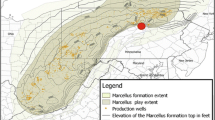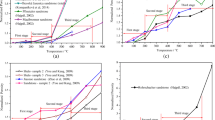Abstract
Water saturation, organic matter content, and fractures are important factors influencing the physical properties of shale. In this study, shale samples were subjected to heating at 1 °C/min and then gradual cooling. An initial suite of tests was conducted at temperatures of 100 °C, 200 °C, 300 °C, 400 °C and 500 °C. The P-wave and S-wave velocities were measured, rock mechanics parameters were calculated, and then the uniaxial compressive strength test was performed. The mineral composition changed at 500 °C and the montmorillonite transformation of the shale to illite and rock diagenesis were gradually enhanced. Under the condition of heating, shale water saturation and organic matter content were reduced. The difference in the thermal mineral grain (thermal expansion anisotropy and inhomogeneous thermal expansion.) caused the corresponding changes in the internal structure of the rocks. When the changes exceeded those of the rock itself to some extent, they tended to produce microcracks within the rock, resulting in a change in the rock mechanics parameters. The results provide the fundamental parameters for rock mechanics and an important guide for high-temperature wellbore stability and hydraulic fracturing.







Similar content being viewed by others
References
Cho, J. W., Kim, H., Jeon, S., & Min, K. B. (2011). An experimental study on deformation and strength anisotropy of transversely isotropic rocks in Korea. In 12th ISRM congress. International society for rock mechanics and rock engineering.
Deng, J. X., Shi, G., Liu, R. X., & Yu, J. (2004). Analysis of the velocity anisotropy and its affection factors in shale and mudstone. Chinese Journal of Geophysics-Chinese Edition, 47(5), 862–868.
Fang, Z., & Harrison, J. P. (2002). Development of a local degradation approach to the modelling of brittle fracture in heterogeneous rocks. International Journal of Rock Mechanics and Mining Sciences, 39(4), 443–457.
Geng, Z., Chen, M., Jin, Y., Yang, S., Yi, Z., Fang, X., et al. (2016). Experimental study of brittleness anisotropy of shale in triaxial compression. Journal of Natural Gas Science and Engineering, 36, 510–518.
Géraud, Y. (1994). Variations of connected porosity and inferred permeability in a thermally cracked granite. Geophysical Research Letters, 21(11), 979–982.
Heard, H. C. (1980). Thermal expansion and inferred permeability of climax quartz monzonite to 300 C and 27.6 MPa. International Journal of Rock Mechanics and Mining Sciences & Geomechanics Abstracts, 17(5), 289–296.
Hettema, M. H. H., Niepce, D. V., & Wolf, K. H. (1999). A microstructural analysis of the compaction of claystone aggregates at high temperatures. International Journal of Rock Mechanics and Mining Sciences, 36(1), 57–68.
Hettema, M. H. H., Wolf, K. A., & De Pater, C. J. (1998). The influence of steam pressure on thermal spalling of sedimentary rock: Theory and experiments. International Journal of Rock Mechanics and Mining Sciences, 35(1), 3–15.
Hornby, B. E., Schwartz, L. M., & Hudson, J. A. (1994). Anisotropic effective-medium modeling of the elastic properties of shales. Geophysics, 59(10), 1570–1583.
Jamaluddin, A. K. M., Bennion, D. B., Thomas, F. B., & Ma, T. (1998). Application of heat treatment to enhance permeability in tight gas reservoirs. In Annual technical meeting. Petroleum Society of Canada.
Keir, D., Belachew, M., Ebinger, C. J., Kendall, J. M., Hammond, J. O., Stuart, G. W., et al. (2011). Mapping the evolving strain field during continental breakup from crustal anisotropy in the Afar Depression. Nature Communications, 2(1), 1–7.
Li, Q., Chen, M., Jin, Y., Zhou, Y., Wang, F. P., & Zhang, R. (2013). Rock mechanical properties of shale gas reservoir and their influences on hydraulic fracture. In IPTC 2013: International petroleum technology conference (p. cp-350). European Association of Geoscientists & Engineers.
Li, X., Lei, X., Li, Q., & Li, X. (2017). Experimental investigation of Sinian shale rock under triaxial stress monitored by ultrasonic transmission and acoustic emission. Journal of Natural Gas Science and Engineering, 43, 110–123.
Liu, K., & Sheng, J. J. (2019). Experimental study of the effect of stress anisotropy on fracture propagation in Eagle Ford shale under water imbibition. Engineering Geology, 249, 13–22.
Liu, J. R., & Wu, X. D. (2008). Microscopic experiment of thermal treated rock. Journal of Southwest Petroleum University (Science & Technology Edition), 29(4), 006.
Liu, S., & Xu, J. (2015). An experimental study on the physico-mechanical properties of two post-high-temperature rocks. Engineering Geology, 185, 63–70.
Meredith, P. G., & Atkinson, B. K. (1985). Fracture toughness and subcritical crack growth during high-temperature tensile deformation of Westerly granite and Black gabbro. Physics of the Earth and Planetary Interiors, 39(1), 33–51.
Nooraiepour, M., Mondol, N. H., Hellevang, H., & Bjørlykke, K. (2017). Experimental mechanical compaction of reconstituted shale and mudstone aggregates: Investigation of petrophysical and acoustic properties of SW Barents Sea cap rock sequences. Marine and Petroleum Geology, 80, 265–292.
Otto, C., & Kempka, T. (2015). Thermo-mechanical simulations of rock behavior in underground coal gasification show negligible impact of temperature-dependent parameters on permeability changes. Energies, 8(6), 5800–5827.
Richter, D., & Simmons, G. (1974). Thermal expansion behavior of igneous rocks. International Journal of Rock Mechanics and Mining Sciences & Geomechanics Abstracts, 11(10), 403–411.
Rickman, R., Mullen, M. J., Petre, J. E., Grieser, W. V., & Kundert, D. (2008). A practical use of shale petrophysics for stimulation design optimization: All shale plays are not clones of the Barnett Shale. In SPE annual technical conference and exhibition. Society of Petroleum Engineers.
Ross, C. M., Rangel-German, E., Castanier, L. M., Hara, P. S., & Kovscek, A. R. (2006). A laboratory investigation of temperature-induced sand consolidation. SPE Journal, 11(02), 206–215.
Saiang, C., & Miskovsky, K. (2011, January). Effect of heat on the mechanical properties of selected rock types–a laboratory study. In 12th ISRM congress. International Society for Rock Mechanics and Rock Engineering.
Sarout, J., & Guéguen, Y. (2008). Anisotropy of elastic wave velocities in deformed shales: Part 2—Modeling results. Geophysics, 73(5), D91–D103.
Somerton, W. H., & Gupta, V. S. (1965). Role of fluxing agents in thermal alteration of sandstones. Journal of Petroleum Technology, 17(05), 585–588.
Somerton, W. H., Mehta, M. M., & Dean, G. W. (1965). Thermal alteration of sandstones. Journal of Petroleum Technology, 17(05), 589–593.
Sondergeld, C. H., Newsham, K. E., Comisky, J. T., Rice, M. C., & Rai, C. S. (2010). Petrophysical considerations in evaluating and producing shale gas resources. In SPE unconventional gas conference. Society of Petroleum Engineers.
Thirumalai, K., & Demou, S. G. (1970). Effect of reduced pressure on thermal-expansion behavior of rocks and its significance to thermal fragmentation. Journal of Applied Physics, 41(13), 5147–5151.
Thomsen, L. (1986). Weak elastic anisotropy. Geophysics, 51(10), 1954–1966.
Tian, H., Ziegler, M., & Kempka, T. (2014). Physical and mechanical behavior of claystone exposed to temperatures up to 1000 C. International Journal of Rock Mechanics and Mining Sciences, 70, 144–153.
Vernik, L., & Nur, A. (1992). Ultrasonic velocity and anisotropy of hydrocarbon source rocks. Geophysics, 57(5), 727–735.
Wang, X., Ge, H., Wang, J., Wang, D., & Chen, H. (2016a). Evaluation of the micro-cracks in shale from the stress sensitivity of ultrasonic velocities. Rock Mechanics and Rock Engineering, 49(12), 4929–4934.
Wang, D., Ge, H., Wang, X., Wang, J., & Meng, F. (2015). The Mechanical properties of gas shale under uniaxial stress. In 13th ISRM international congress of rock mechanics. International Society for Rock Mechanics and Rock Engineering.
Wang, Y., & Li, C. H. (2017). Investigation of the P-and S-wave velocity anisotropy of a Longmaxi formation shale by real-time ultrasonic and mechanical experiments under uniaxial deformation. Journal of Petroleum Science and Engineering, 158, 253–267.
Wang, J., Xie, L., Xie, H., Ren, L., He, B., Li, C., et al. (2016b). Effect of layer orientation on acoustic emission characteristics of anisotropic shale in Brazilian tests. Journal of Natural Gas Science and Engineering, 36, 1120–1129.
Waters, G. A., Lewis, R. E., & Bentley, D. (2011). The effect of mechanical properties anisotropy in the generation of hydraulic fractures in organic shales. In SPE annual technical conference and exhibition. Society of Petroleum Engineers.
White, J. E., MARTINEAU-NICOLETIS, L., & Monash, C. (1983). Measured anisotropy in Pierre shale. Geophysical Prospecting, 31(5), 709–725.
Winterstein, D. F., & Paulsson, B. N. P. (1990). Velocity anisotropy in shale determined from crosshole seismic and vertical seismic profile data. Geophysics, 55(4), 470–479.
Wu, X. D., Liu, J. R., & Qin, J. S. (2003). Effects of thermal treatment on wave velocity as well as porosity and permeability of rock. Journal-University of Petroleum China Natural Science Edition, 27(4; ISSU 138), 70–72.
Xing, Z., Beaucour, A. L., Hebert, R., Noumowe, A., & Ledesert, B. (2011). Influence of the nature of aggregates on the behaviour of concrete subjected to elevated temperature. Cement and Concrete Research, 41(4), 392–402.
Yang, S. Q., Xu, P., Li, Y. B., & Huang, Y. H. (2017). Experimental investigation on triaxial mechanical and permeability behavior of sandstone after exposure to different high temperature treatments. Geothermics, 69, 93–109.
Yong, C., & Wang, C. Y. (1980). Thermally induced acoustic emission in Westerly granite. Geophysical Research Letters, 7(12), 1089–1092.
Yu, S., Hong-kui, G., Xiao-qiong, W., Fan-bao, M., & Jun-rong, L. (2018). Instruments and methods with high-precision for wave velocity measurement on shale debris. Rock and Soil Mechanics, 39(1), 385–392.
Zhu, Z. N., Tian, H., Jiang, G. S., & Cheng, W. (2018). Effects of high temperature on the mechanical properties of Chinese marble. Rock Mechanics and Rock Engineering, 51(6), 1937–1942.
Zhubayev, A., Houben, M. E., Smeulders, D. M., & Barnhoorn, A. (2016). Ultrasonic velocity and attenuation anisotropy of shales, Whitby. United Kingdom. Geophysics, 81(1), D45–D56.
Zomeni, Z. (1997). Thermally induced microfracturing in quartzite. Masters of Science dissertation, Mining and Geological Engineering, The University of Arizona, Tucson, 199.
Author information
Authors and Affiliations
Corresponding author
Rights and permissions
About this article
Cite this article
Suo, Y., Chen, Z. & Rahman, S.S. Changes in Shale Rock Properties and Wave Velocity Anisotropy Induced by Increasing Temperature. Nat Resour Res 29, 4073–4083 (2020). https://doi.org/10.1007/s11053-020-09693-5
Received:
Accepted:
Published:
Issue Date:
DOI: https://doi.org/10.1007/s11053-020-09693-5




